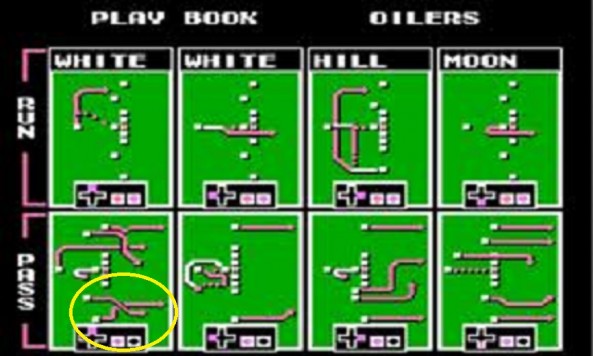For those of you who like X's and O's, the folks over at Spread Football were kind enough to post notes from the 2013 Notre Dame Coaches Clinic on their site. The notes are very informative and fun to read during the football-starved offseason. While there are a number of interesting tidbits from this year's clinic notes, I found the diagrams of the Switch concept particularly interesting.
What is the Switch?
The Switch was a staple of the Run & Shoot offense. It is a two-man route concept where the receivers cross paths (or switch) before releasing vertically. The outside receiver slants inside before running down the seam, while the inside receiver runs a wheel route down the sideline. Against man coverage, the Switch often creates a pick that can free up one or both receivers. Against zone coverage, the Switch can put deep defenders in a bind by forcing them to choose between covering the seam or the sideline.
Like most Run & Shoot route concepts, the Switch traditionally required the receivers to read the defense and alter their routes based on the coverage. For example, if the defender stayed deep, the receiver might stop and curl back to the quarterback. Some coaches, however, have eliminated the reads and simply instruct the receivers to run verticals after they cross paths. Based on the following diagram from the clinic notes, it appears the Irish coaches are among those who have eliminated the reads.
(via Spread Football)
Attacking the Boundary
If you've watched many Notre Dame games in recent years, you've probably noticed that the coaching staff will often set the strength of the formation to the boundary. Setting the strength of the formation to the boundary gives the offense an advantage because most defenses are field-strength based. In addition to setting the strength of the formation to the boundary, the coaching staff will frequently put their best receivers to boundary. Attacking the boundary in this manner allows the offense to create mismatches against inferior defenders.
Below is an example of the Irish offense attacking the boundary with the Switch concept in the Blue-Gold game.
The play call is a variation of the popular "four verticals" play. The offense lines up in a two-tight end set with Davaris Daniels as the boundary receiver and Troy Niklas as the boundary tight end running the Switch. The defense lines up with a single-high safety, i.e., a good indicator that they are playing Cover 1 or Cover 3.
With the corners bailing at the snap and the linebackers spreading to cover the underneath zones, it appears the the defense is playing Cover 3 (Sky). The goal of four verticals against Cover 3 is typically not to hit the deep ball but to attack the defense between the second and third levels. Everett Golson's initial read is likely Daniels down the seam, but Carlo Calabrese rotates over to take Daniels out of the play.
Golson eventually locates Niklas and throws a perfect back-shoulder pass before Josh Atkinson can rotate over to make a play. Although Ishaq Williams did a good job recognizing the wheel route and expanding his zone to prevent Niklas from running free down the sideline, he lost his footing turning back for the ball. This play ended up being one of the few bright spots for the offense during the scrimmage.
As you can see from the previous example, the coaching staff does not limit the Switch only to formations with twin receivers. Notre Dame runs the Switch from multiple formations with various combinations of receivers, tight ends and running backs. Here's a great video of Tyler Eifert and Theo Riddick running the Switch against Purdue.
Conclusion
The Switch is a great concept that can be effective against both man and zone defenses. Look for Notre Dame to continue utilizing the Switch this fall, particularly when attacking the boundary. Go Irish!






























